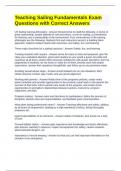Teaching Sailing Fundamentals Exam
Questions with Correct Answers
US Sailing training philosophy - Answer-Should strive to instill the following: A sense of
good seamanship, proper attitude for self and others, a love for sailing, a commitment
for learning, and a stewardship of the environment. Four cornerstones of the training
philosophy are the following: Students first and instructors second, a building block
approach, balance student needs with outcomes, and safety, fun, and learning.
Three major directives for a sailing instructor - Answer-Safety, fun, and learning
Treating students with respect - Answer-arrive for class on time and prepared, give the
class your undivided attention, greet each student as you would a guest, be polite and
courteous at all times, protect their personal confidences with proper discretion, don't be
judgmental of students, do not mock or make fun of them, provide each with ample
supervision, answer their questions thoughtfully, and follow up on any promises made.
Avoiding sexual abuse steps - Answer-Avoid isolated one on one situations, don't
initiate physical contact, play it safe, and use good judgement.
Working with parents - Answer-Notify them of the programs policies, create many
parent activities and provide opportunities to be involved, report back to the parents the
success of their kids, inform parents any needs of the program, and create social
opportunities to strengthen relationships between parents, instructors, program
organizers, and kids.
Program policies - Answer-rules and directions for participation, define the process of
discipline, identify roles and responsibilities, and facilitate good communication.
What does being professional mean? - Answer-Teaching effectively and safely, abiding
by all terms of employment, abiding by a high standards of ethics, being thoroughly
prepared, etc.
legal responsibilities of an instructor - Answer-safety of students, also known as a duty
of care,
Prevent liability claims: - Answer-gain experience and knowledge and teach effectively,
plan lessons carefully in advance, inspect all equipment for safety, caution students
about potential dangers, etc
Importance of record keeping - Answer-So that you can find important information in the
situation of an emergency
, Behavior guideline for instructors - Answer-No alcohol, smoking, clean appearance,
neat clothing, groomed hair, close toed shoes, life jackets, no foul language, give no
prescriptions, and professional behavior.
instructor time management tips - Answer-make a to do list every day, list most
important things first, start early in the day, do things in order of priority, delegate when
possible, budget time as though it were money, tell people how much time you have for
them, stick to your schedule, and adhere to a daily routine
USCG licenses - Answer-Not required if teaching on non motorized sailboat or on
motorized safety boat without children on board.
Risks in sailing - Answer-legal and moral responsibility, working with kids requires
increased supervision, skill level depends on instructor, small boats in deep water,
teaching from a powerboat has its own risks, and the environment/ weather. Sailors are
liable and have a duty of care to their students, property, and environment,
Legal liability risks two sections - Answer-Regulatory risks: Required launch operators
to have appropriate license, controlling pollution, requiring powerboats to be registered
and inspected
Contract and torn lability: negligence, battery, assault, defamation, invasion of privacy.
Four elements of negligence - Answer-legal duty to the injured party, failed to fulfill your
duty, injury had to occur to the party to whom you owed the duty, and your failure of the
duty caused the injury
three defenses for negligence - Answer-show that not all the elements of negligence
were present, direct causes of injury were an act of god, and show the injured part is
guilty of contributory negligence, he/she caused the injury
legal actions - Answer-civil lawsuit: aggravated party, plaintiff, seeking monetary
judgement for harm of injury they suffered
Criminal case: similar to above, expect incarceration is expected, not monetary value
Risk management goals - Answer-Prevent injury or harm, recognize dangerous
situations, reduce number of all accidents, be prepared for the contingency of an
emergency, and monitor and adjust as exposures change and develop
Process for risk management - Answer-identify risks, evaluate for best treatment,
resolved the identified risks,
Risk identification - Answer-site assessment: identifying areas or items that may lead to
injury around the facility, the docks, and the boats themselves
risk resolution - Answer-1. eliminate the risk
2. reduce the probability that it will lead to a serious injury (ex: wearing shoes)




